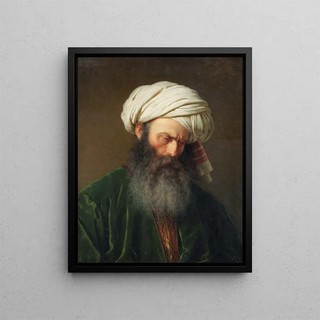Art print | Study of a man in Turkish costume - Amalia Lindegren Source: Reproduction | Étude d'un homme en costume turc - Amalia Lindegren


View from behind

Frame (optional)
In the fascinating world of art, some works stand out for their ability to capture the essence of an era, a culture, or an emotion. "Study of a Man in a Turkish Costume" by Amalia Lindegren is one of those creations that transports the viewer to the heart of the 19th century, a period of great upheavals and cultural exchanges. This piece, both delicate and powerful, invites deep contemplation, offering a glimpse into the oriental influences that have marked European art. Through the penetrating gaze of the depicted figure, Lindegren engages us in a reflection on identity, exoticism, and timeless beauty.
Style and uniqueness of the work
Amalia Lindegren's work is distinguished by its realistic approach and attention to detail. In "Study of a Man in a Turkish Costume," each element of the costume is carefully rendered, from embroidery to fabric textures, demonstrating impressive technical mastery. The color palette chosen by the artist evokes both the richness of oriental cultures and the aesthetic sensitivity of her time. The posture of the figure, both proud and contemplative, suggests a psychological depth that prompts reflection on his personal history. This blend of realism and symbolism gives the work a universal dimension, allowing each viewer to project their own emotions and thoughts onto it.
The artist and her influence
Amalia Lindegren, an emblematic figure of the Swedish artistic movement, managed to establish herself in a world dominated by male artists. Her training at the Royal Swedish Academy of Arts in Stockholm and her travels across Europe enriched her style and broadened her horizons. Influenced by Romanticism and Orientalism, Lindegren was able to incorporate these currents into her work while infusing it with her own sensitivity. Her work on "Study of a Man in a Turkish Costume" reflects this influence, but also her desire to explore identity and cultural themes. By depicting figures of diverse origins, she contributed to opening a dialogue on otherness and perception of the other—questions still relevant in our contemporary society.

Matte finish

View from behind

Frame (optional)
In the fascinating world of art, some works stand out for their ability to capture the essence of an era, a culture, or an emotion. "Study of a Man in a Turkish Costume" by Amalia Lindegren is one of those creations that transports the viewer to the heart of the 19th century, a period of great upheavals and cultural exchanges. This piece, both delicate and powerful, invites deep contemplation, offering a glimpse into the oriental influences that have marked European art. Through the penetrating gaze of the depicted figure, Lindegren engages us in a reflection on identity, exoticism, and timeless beauty.
Style and uniqueness of the work
Amalia Lindegren's work is distinguished by its realistic approach and attention to detail. In "Study of a Man in a Turkish Costume," each element of the costume is carefully rendered, from embroidery to fabric textures, demonstrating impressive technical mastery. The color palette chosen by the artist evokes both the richness of oriental cultures and the aesthetic sensitivity of her time. The posture of the figure, both proud and contemplative, suggests a psychological depth that prompts reflection on his personal history. This blend of realism and symbolism gives the work a universal dimension, allowing each viewer to project their own emotions and thoughts onto it.
The artist and her influence
Amalia Lindegren, an emblematic figure of the Swedish artistic movement, managed to establish herself in a world dominated by male artists. Her training at the Royal Swedish Academy of Arts in Stockholm and her travels across Europe enriched her style and broadened her horizons. Influenced by Romanticism and Orientalism, Lindegren was able to incorporate these currents into her work while infusing it with her own sensitivity. Her work on "Study of a Man in a Turkish Costume" reflects this influence, but also her desire to explore identity and cultural themes. By depicting figures of diverse origins, she contributed to opening a dialogue on otherness and perception of the other—questions still relevant in our contemporary society.






